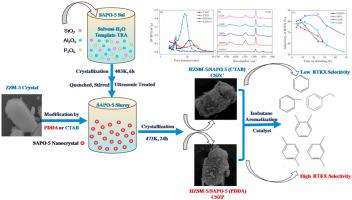Journal of Physics and Chemistry of Solids ( IF 4.3 ) Pub Date : 2021-06-01 , DOI: 10.1016/j.jpcs.2021.110194 Ruizhen Zhang , Jie Wang , Lina Han , Jiancheng Wang , Liangfu Zhao

|
HZSM-5 molecular sieves are efficient catalysts in the aromatization of light hydrocarbons and the fabrication of HZSM-5-based core–shell composites has become an important strategy to improve their catalytic performance due to the simultaneous modification of the acidity and pore structures in the catalyst. In this paper, HZSM-5/SAPO-5 (CSZP and CSZC) were synthesized via a two-stage crystallization process using PDDA and CTAB as modifiers of HZSM-5, respectively. The structure, acidity, and the weight of carbon deposition of the resulting molecular sieves catalysts were characterized using various methods and their catalytic behavior in isobutane aromatization investigated. The results show that CSZP exhibits a perfect core–shell structure with a uniform and thin shell composed of nano-SAPO-5, while CSZC has an irregular coat configuration with HZSM-5 covered by a rough and thick shell consisting of flaky micro-SAPO-5 crystals. The introduction of SAPO-5 via an in-situ synthesis decreases the Brønsted acidity of the catalysts to different extents and provides a large number of intergranular mesopores due to the stacking of SAPO-5 on the surface of HZSM-5, which is favorable toward improving the BTEX selectivity (benzene, toluene, ethylbenzene, and xylene) and catalytic stability over CSZP and CSZC. Meanwhile, CSZP has more competitive advantages than CSZC in promoting the mass transfer efficiency due to its significantly thinner shell than CSZC, which combined with its moderate acidity and appropriate mesopore structure result in its excellent selectivity and stability during the aromatization of isobutane.
中文翻译:

利用 HZSM-5/SAPO-5 沸石在异丁烷转化中的核壳协同效应提高芳烃选择性
HZSM-5 分子筛是轻烃芳构化的有效催化剂,由于 HZSM-5 基核壳复合材料的制备已成为提高其催化性能的重要策略,因为它同时改变了轻烃中的酸度和孔结构。催化剂。在本文中,分别使用 PDDA 和 CTAB 作为 HZSM-5 的改性剂,通过两阶段结晶过程合成了 HZSM-5/SAPO-5(CSZP 和 CSZC)。使用各种方法表征所得分子筛催化剂的结构、酸度和积碳重量,并研究它们在异丁烷芳构化中的催化行为。结果表明,CSZP 具有完美的核壳结构,具有由纳米 SAPO-5 组成的均匀薄壳,而 CSZC 具有不规则的涂层结构,HZSM-5 被由片状微 SAPO-5 晶体组成的粗糙厚壳覆盖。通过原位合成引入 SAPO-5 不同程度地降低了催化剂的布朗斯台德酸度,并由于 SAPO-5 堆积在 HZSM-5 表面上提供了大量的粒间介孔,这有利于与 CSZP 和 CSZC 相比,提高了 BTEX 选择性(苯、甲苯、乙苯和二甲苯)和催化稳定性。同时,CSZP由于其壳比CSZC显着更薄,在促进传质效率方面比CSZC更具竞争优势,再加上其适中的酸度和适当的介孔结构使其在异丁烷芳构化过程中具有优异的选择性和稳定性。











































 京公网安备 11010802027423号
京公网安备 11010802027423号